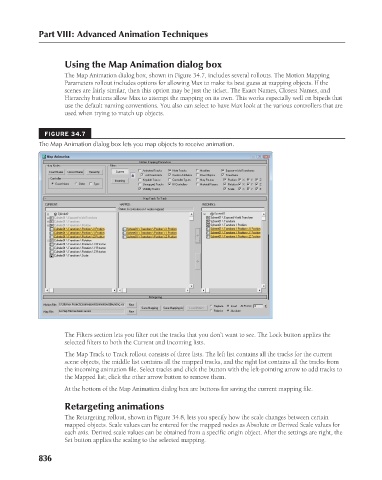Page 884 - Kitab3DsMax
P. 884
Part VIII: Advanced Animation Techniques
Using the Map Animation dialog box
The Map Animation dialog box, shown in Figure 34.7, includes several rollouts. The Motion Mapping
Parameters rollout includes options for allowing Max to make its best guess at mapping objects. If the
scenes are fairly similar, then this option may be just the ticket. The Exact Names, Closest Names, and
Hierarchy buttons allow Max to attempt the mapping on its own. This works especially well on bipeds that
use the default naming conventions. You also can select to have Max look at the various controllers that are
used when trying to match up objects.
FIGURE 34.7
The Map Animation dialog box lets you map objects to receive animation.
The Filters section lets you filter out the tracks that you don’t want to see. The Lock button applies the
selected filters to both the Current and Incoming lists.
The Map Track to Track rollout consists of three lists. The left list contains all the tracks for the current
scene objects, the middle list contains all the mapped tracks, and the right list contains all the tracks from
the incoming animation file. Select tracks and click the button with the left-pointing arrow to add tracks to
the Mapped list; click the other arrow button to remove them.
At the bottom of the Map Animation dialog box are buttons for saving the current mapping file.
Retargeting animations
The Retargeting rollout, shown in Figure 34.8, lets you specify how the scale changes between certain
mapped objects. Scale values can be entered for the mapped nodes as Absolute or Derived Scale values for
each axis. Derived scale values can be obtained from a specific origin object. After the settings are right, the
Set button applies the scaling to the selected mapping.
836

